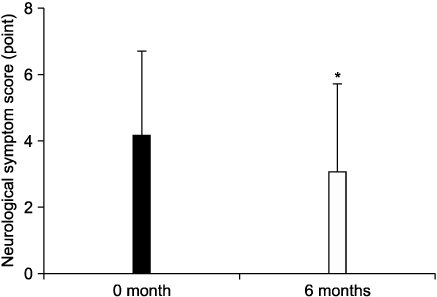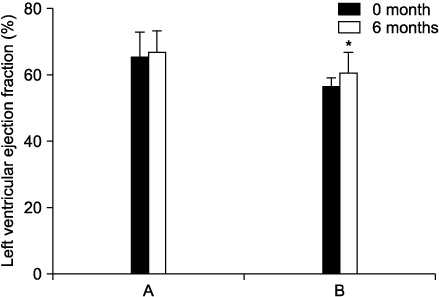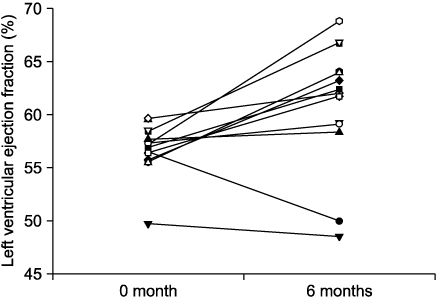Ewha Med J.
2012 Sep;35(2):89-94. 10.12771/emj.2012.35.2.89.
The Effects of Carnitine Supplementation in Hemodialysis Patients
- Affiliations
-
- 1Department of Internal Medicine, Ewha Womans University School of Medicine, Seoul, Korea. sjkimwon@ewha.ac.kr
- KMID: 2283998
- DOI: http://doi.org/10.12771/emj.2012.35.2.89
Abstract
OBJECTIVES
Patients receiving hemodialysis have been shown to be carnitine deficient due to many causes. Tissues, especially the skeletal muscle and myocardium, require carnitine for the production of energy. This study was performed to find out the effects of L-carnitine supplementation on muscular symptoms and cardiac functions in dialysis patients.
METHODS
Among 72 hemodialysis patients, 40 patients who showed decreased free carnitine levels were selected to receive L-carnitine intravenously after each hemodialysis session for 6 months. Before and after supplementation, echocardiography, various neurologic examinations and questionnaires were obtained.
RESULTS
After carnitine treatment for 6 months (1~1.5 g per every hemodialysis session), the blood level of carnitine was increased more than 10 times (19.04+/-7.12 micromol/L vs. 267.24+/-69.94 micromol/L, P<0.001). The left ventricular ejection fraction was improved in the patients who have less than 60% of ejection fraction (56.45+/-2.53% vs. 60.44+/-6.29%, P=0.03) after carnitine treatment. The neurological symptom score and isometric muscle power (pinch power) were improved, but the total neuropathy score, activities of daily living scale and grip power were not changed after carnitine supplementation on dialysis patients.
CONCLUSION
Regular L-carnitine supplementation on hemodialysis patients can improve their left ventricular ejection fraction and some parts of functionality.
Keyword
MeSH Terms
Figure
Reference
-
1. USRDS: US Renal Data System. Am J Kidney Dis. 2003. 42:6 Suppl 5. 1–230.2. Evans AM, Faull R, Fornasini G, Lemanowicz EF, Longo A, Pace S, et al. Pharmacokinetics of L-carnitine in patients with end-stage renal disease undergoing long-term hemodialysis. Clin Pharmacol Ther. 2000. 68:238–249.3. Schreiber B. Levocarnitine and dialysis: a review. Nutr Clin Pract. 2005. 20:218–243.4. Fritz IB. Carnitine and its role in fatty acid metabolism. Adv Lipid Res. 1963. 1:285–334.5. Chazot C, Laurent G, Charra B, Blanc C, VoVan C, Jean G, et al. Malnutrition in long-term haemodialysis survivors. Nephrol Dial Transplant. 2001. 16:61–69.6. Rocchi L, Feola I, Calvani M, D'Iddio S, Alfarone C, Frascarelli M. Effects of carnitine administration in patients with chronic renal failure undergoing periodic dialysis, evaluated by computerized electromyography. Drugs Exp Clin Res. 1986. 12:707–711.7. Ahmad S, Robertson HT, Golper TA, Wolfson M, Kurtin P, Katz LA, et al. Multicenter trial of L-carnitine in maintenance hemodialysis patients. II. Clinical and biochemical effects. Kidney Int. 1990. 38:912–918.8. Brass EP, Adler S, Sietsema KE, Hiatt WR, Orlando AM, Amato A. Intravenous L-carnitine increases plasma carnitine, reduces fatigue, and may preserve exercise capacity in hemodialysis patients. Am J Kidney Dis. 2001. 37:1018–1028.9. Siami G, Clinton ME, Mrak R, Griffis J, Stone W. Evaluation of the effect of intravenous L-carnitine therapy on function, structure and fatty acid metabolism of skeletal muscle in patients receiving chronic hemodialysis. Nephron. 1991. 57:306–313.10. van Es A, Henny FC, Kooistra MP, Lobatto S, Scholte HR. Amelioration of cardiac function by L-carnitine administration in patients on haemodialysis. Contrib Nephrol. 1992. 98:28–35.11. Romagnoli GF, Naso A, Carraro G, Lidestri V. Beneficial effects of L-carnitine in dialysis patients with impaired left ventricular function: an observational study. Curr Med Res Opin. 2002. 18:172–175.12. Matsumoto Y, Sato M, Ohashi H, Araki H, Tadokoro M, Osumi Y, et al. Effects of L-carnitine supplementation on cardiac morbidity in hemodialyzed patients. Am J Nephrol. 2000. 20:201–207.13. Sakurabayashi T, Miyazaki S, Yuasa Y, Sakai S, Suzuki M, Takahashi S, et al. L-carnitine supplementation decreases the left ventricular mass in patients undergoing hemodialysis. Circ J. 2008. 72:926–931.14. Oh JY, Kim SJ. Effects of L-carnitine supplementation on anemia in patients undergoing hemodialysis. Korean J Med. 2006. 71:285–292.15. Sohn HJ, Choi GB, Yoon KI. L-carnitine in maintenance hemodialysis clinical, lipid and biochemical effects. Korean J Nephrol. 1992. 11:260–269.16. Yoon HR, Hong YM, Boriack RL, Bennett MJ. Effect of L-carnitine supplementation on cardiac carnitine palmitoyltransferase activities and plasma carnitine concentrations in adriamycin-treated rats. Pediatr Res. 2003. 53:788–792.17. Dyck PJ, Bushek W, Spring EM, Karnes JL, Litchy WJ, O'Brien PC, et al. Vibratoty and cooling detection thresholds compared with other tests in diagnosing and staging diabetic neuropathy. Diabetes Care. 1987. 10:432–440.18. Cornblath DR, Chaudhry V, Carter K, Lee D, Seysedadr M, Miernicki M, et al. Total neuropathy score validation and reliability study. Neurology. 1999. 53:1660–1664.19. Schwab R, England A. Gillingham J, Donaldson L, editors. Projection technique for evaluating surgery in Parkinson's disease. Third symposium on Parkinson's disease. 1969. Edinburgh, UK: Livingston;152–157.20. Painter P, Messer-Rehak D, Hanson P, Zimmerman SW, Glass NR. Exercise capacity in hemodialysis, CAPD, and renal transplant patients. Nephron. 1986. 42:47–51.21. Ifudu O, Mayers J, Matthew J, Tan CC, Cambridge A, Friedman EA. Dismal rehabilitation in geriatric inner-city hemodialysis patients. JAMA. 1994. 271:29–33.22. Johansen KL. Physical functioning and exercise capacity in patients on dialysis. Adv Ren Replace Ther. 1999. 6:141–148.23. Rogerson ME, Rylance PB, Wilson R, De Sousa C, Lanigan C, Rose PE, et al. Carnitine and weakness in haemodialysis patients. Nephrol Dial Transplant. 1989. 4:366–371.24. Semeniuk J, Shalansky KF, Taylor N, Jastrzebski J, Cameron EC. Evaluation of the effect of intravenous L-carnitine on quality of life in chronic hemodialysis patients. Clin Nephrol. 2000. 54:470–477.25. Stack AG, Bloembergen WE. A cross-sectional study of the prevalence and clinical correlates of congestive heart failure among incident US dialysis patients. Am J Kidney Dis. 2001. 38:992–1000.26. Trespalacios FC, Taylor AJ, Agodoa LY, Bakris GL, Abbott KC. Heart failure as a cause for hospitalization in chronic dialysis patients. Am J Kidney Dis. 2003. 41:1267–1277.27. Sakurabayashi T, Takaesu Y, Haginoshita S, Takeda T, Aoike I, Miyazaki S, et al. Improvement of myocardial fatty acid metabolism through L-carnitine administration to chronic hemodialysis patients. Am J Nephrol. 1999. 19:480–484.28. Fagher B, Cederblad G, Monti M, Olsson L, Rasmussen B, Thysell H. Carnitine and left ventricular function in haemodialysis patients. Scand J Clin Lab Invest. 1985. 45:193–198.
- Full Text Links
- Actions
-
Cited
- CITED
-
- Close
- Share
- Similar articles
-
- L-carnitine in maintenance hemodialysis clinical, lipid and biochemical effects
- Effects of L-carnitine supplementation on anemia in patients undergoing hemodialysis
- Effects of Dietary Supplementation of Taurine, Carnitine or Glutamine on Endurance Exercise Performance and Fatigue Parameters in Athletes
- Effects of Short-Term Supplementation of Carnitine on Plasma and Urinary Carnitine and Plasma Lipid Levels of Healthy Male Adults
- Effects of Parenteral Carnitine Supplemantation in Very Low Birth Weight Infants Receiving Totla Parentareal Nutrition





